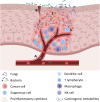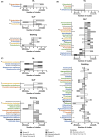Bacteriome and mycobiome dysbiosis in oral mucosal dysplasia and oral cancer
- PMID: 38501658
- PMCID: PMC11579824
- DOI: 10.1111/prd.12558
Bacteriome and mycobiome dysbiosis in oral mucosal dysplasia and oral cancer
Abstract
It has long been considered that the oral microbiome is tightly connected to oral health and that dysbiotic changes can be detrimental to the occurrence and progression of dysplastic oral mucosal lesions or oral cancer. Improved understanding of the concepts of microbial dysbiosis together with advances in high-throughput molecular sequencing of these pathologies have charted in greater microbiological detail the nature of their clinical state. This review discusses the bacteriome and mycobiome associated with oral mucosal lesions, oral candidiasis, and oral squamous cell carcinoma, aiming to delineate the information available to date in pursuit of advancing diagnostic and prognostic utilities for oral medicine.
Keywords: bacteriome; dysbiosis; microbiome; mycobiome; oral cancer; oral candidiasis; oral dysplasia; oral medicine; oral mucosa; oral pathology.
© 2024 The Authors. Periodontology 2000 published by John Wiley & Sons Ltd.
Conflict of interest statement
The authors declare no conflicts of interest.
Figures


References
-
- Ng E, Tay JRH, Balan P, et al. Metagenomic sequencing provides new insights into the subgingival bacteriome and aetiopathology of periodontitis. J Periodontal Res. 2021;56(2):205‐218. - PubMed
-
- Bostanci N, Grant M, Bao K, et al. Metaproteome and metabolome of oral microbial communities. Periodontol 2000. 2021;85(1):46‐81. - PubMed
Publication types
MeSH terms
Grants and funding
LinkOut - more resources
Full Text Sources
Medical

